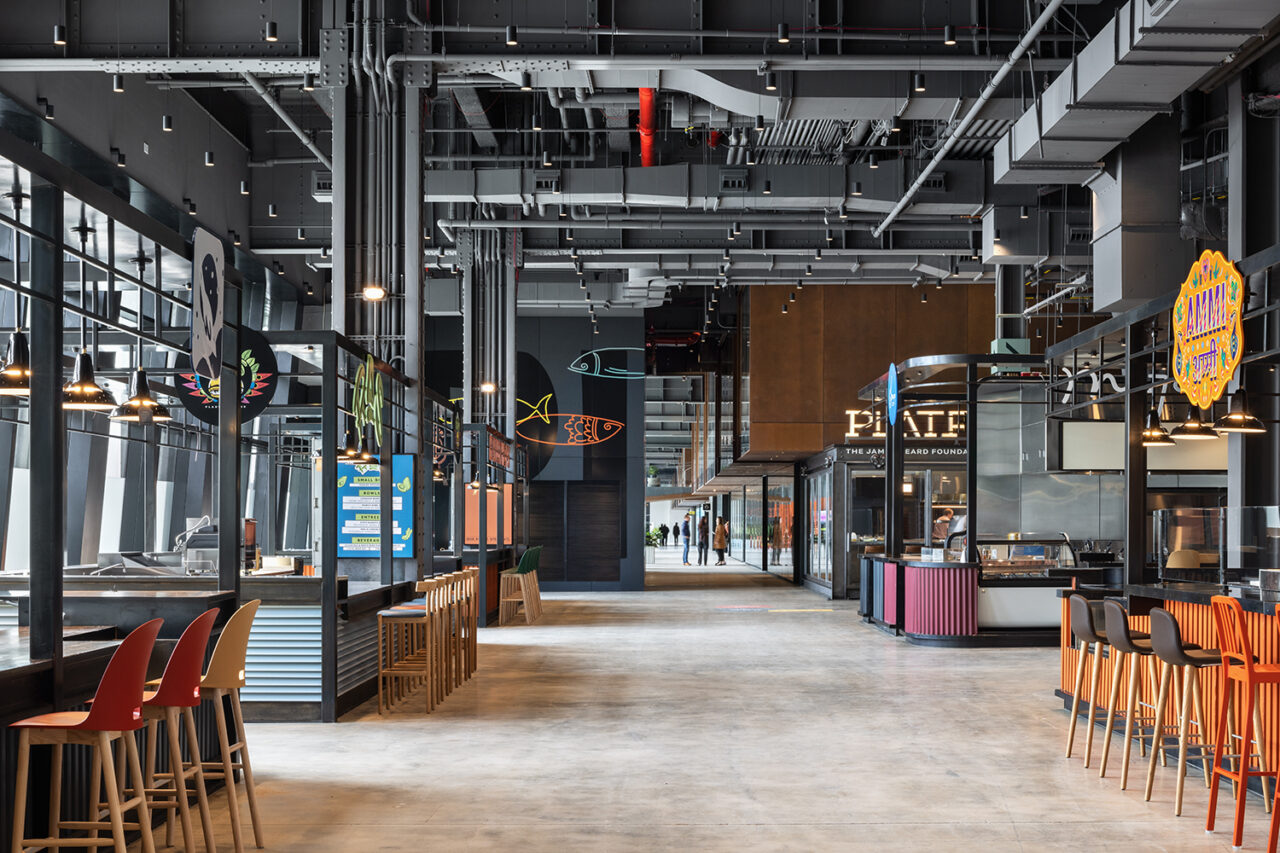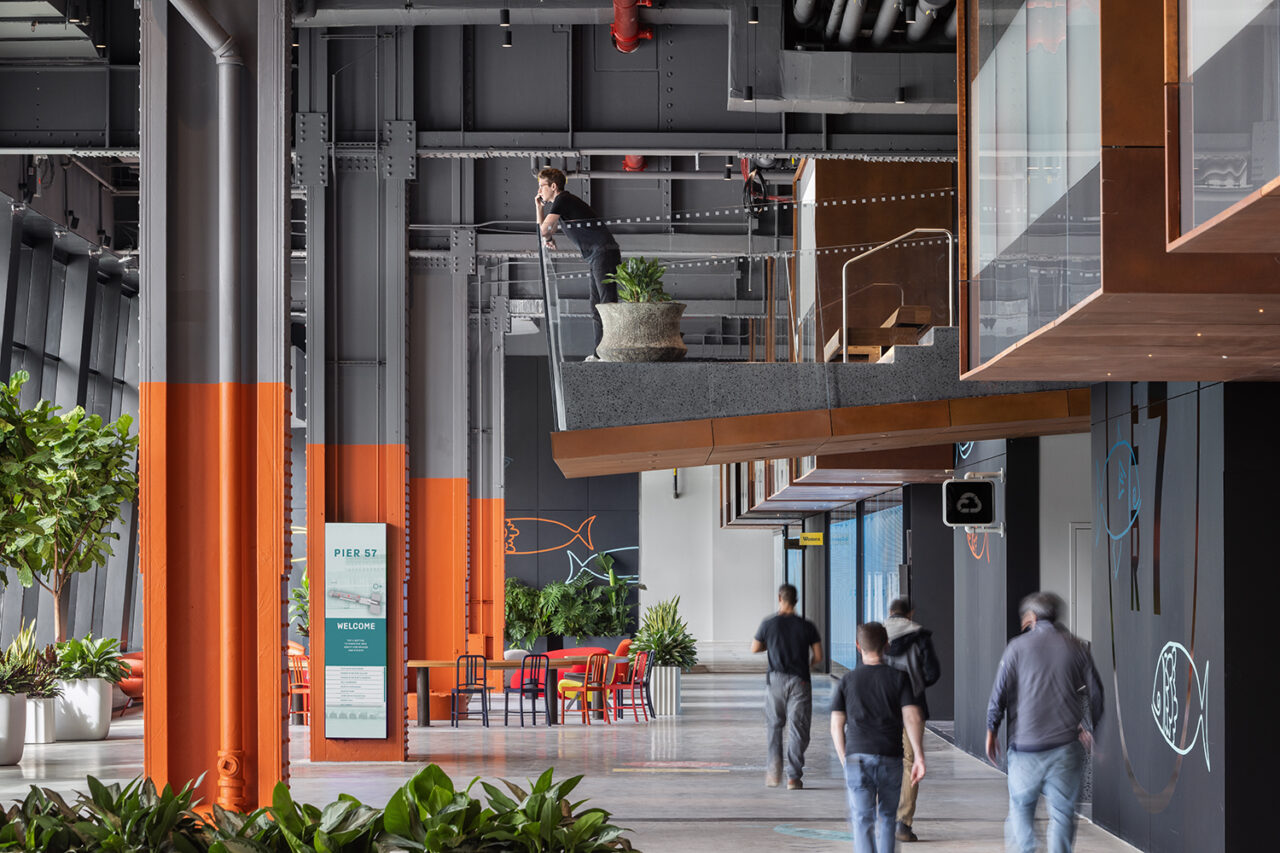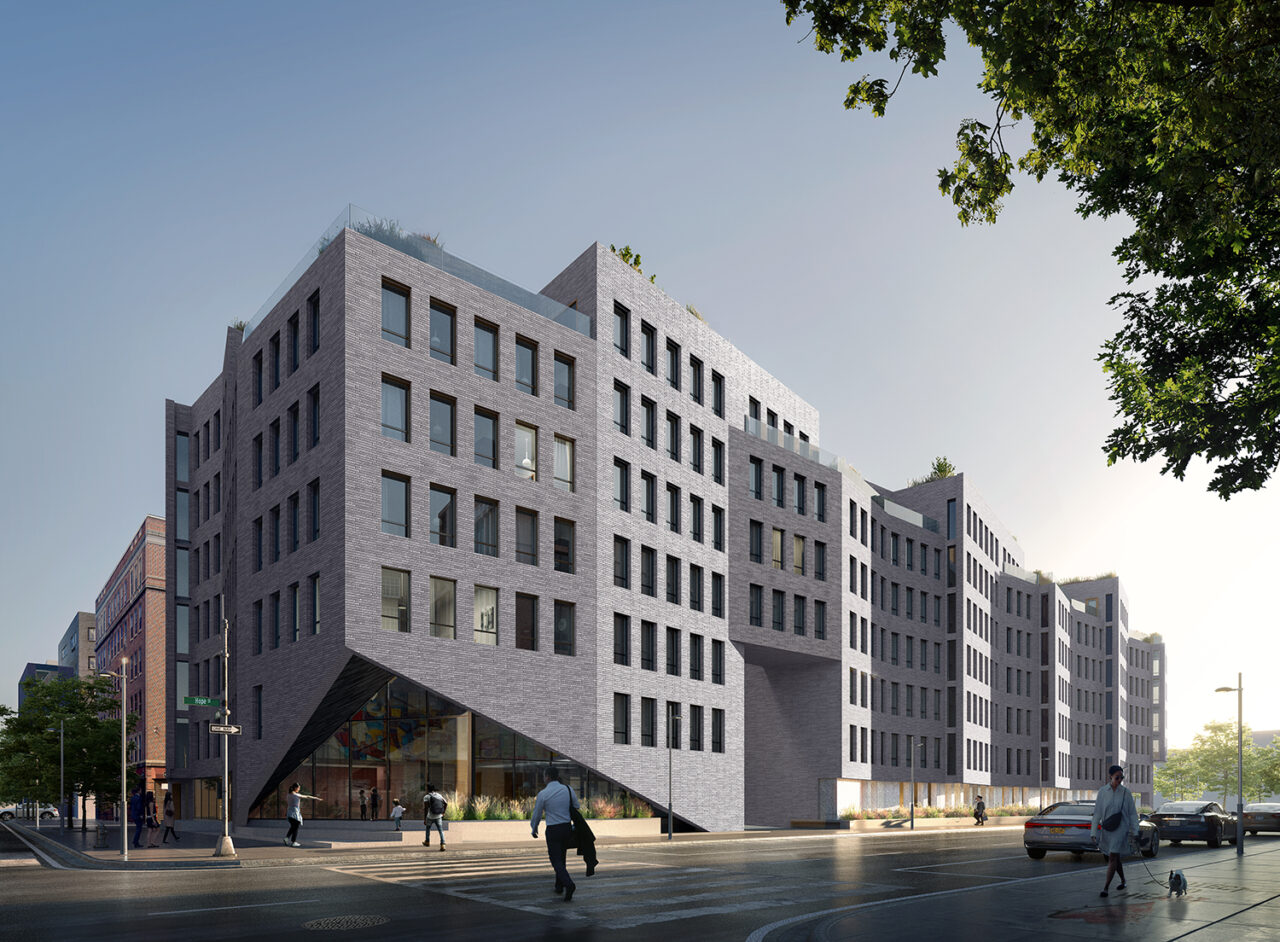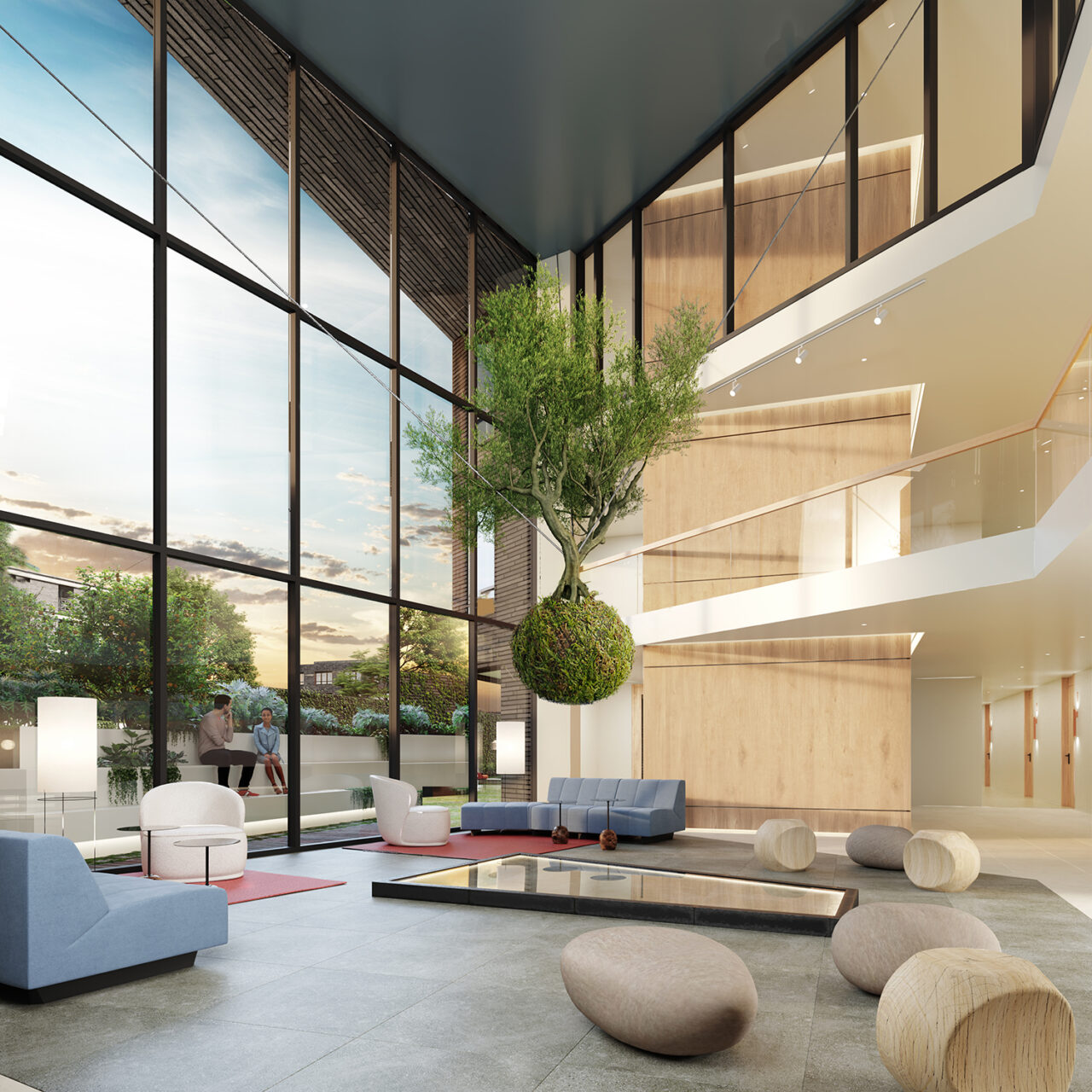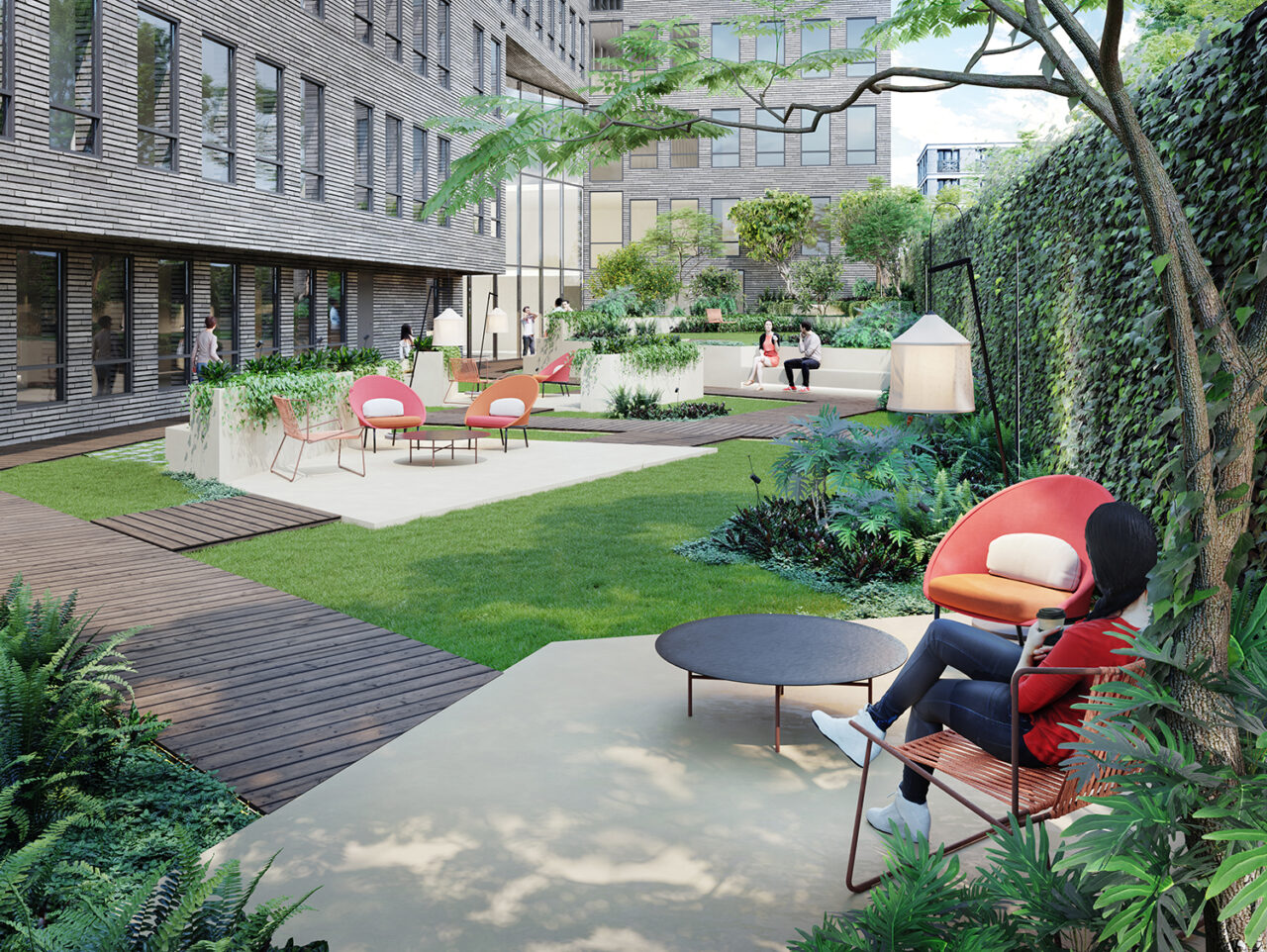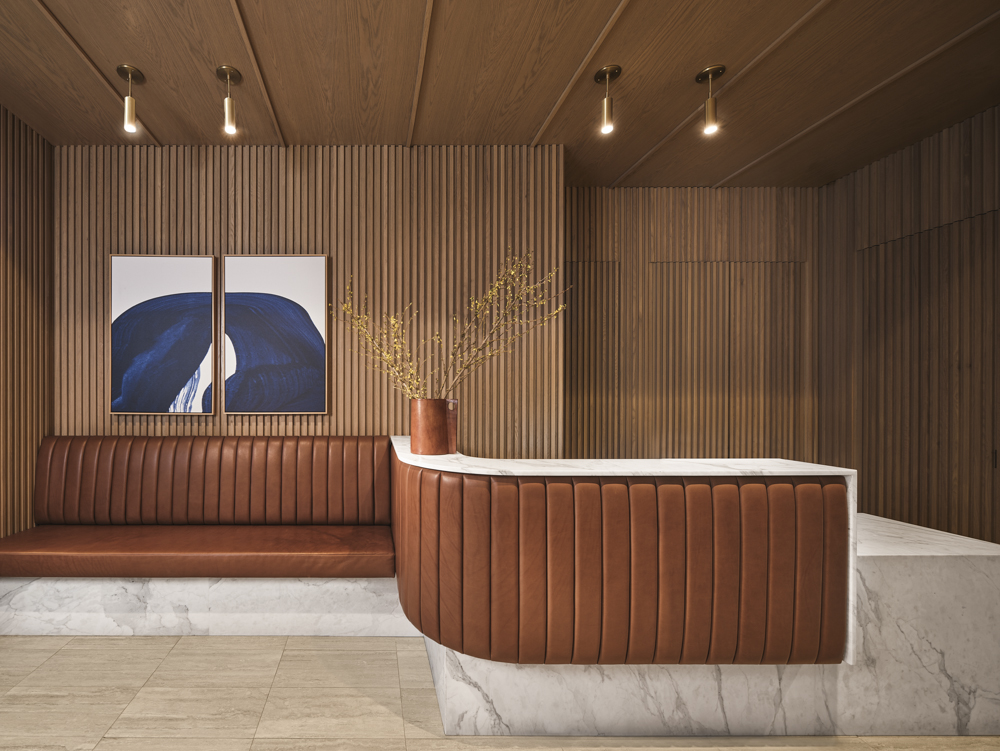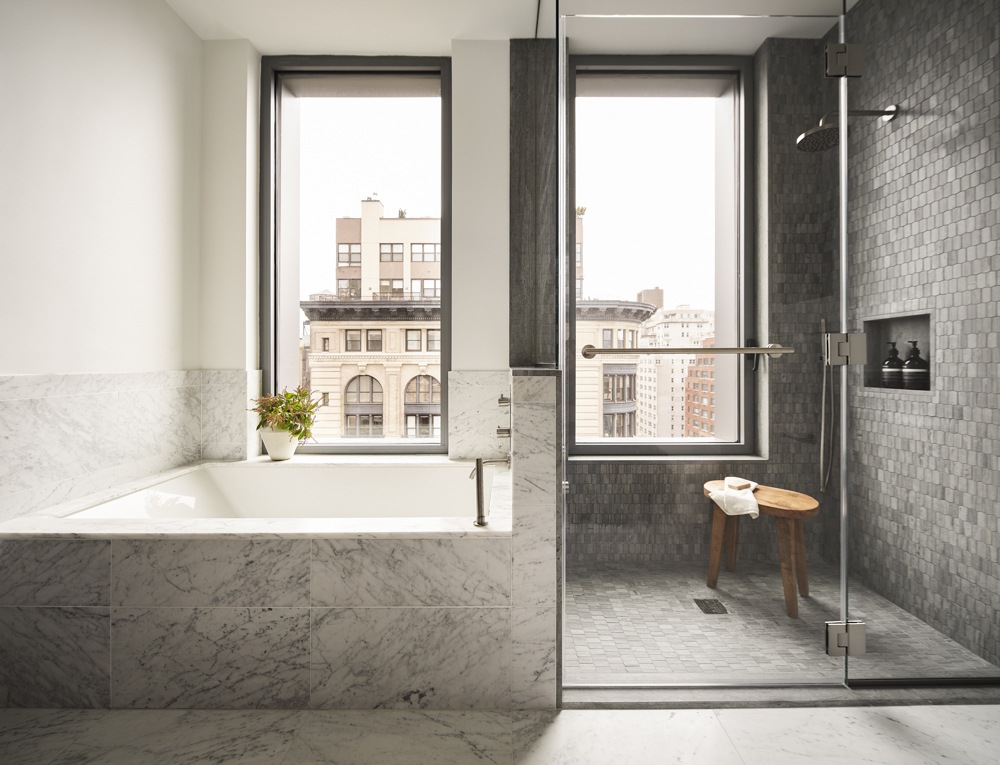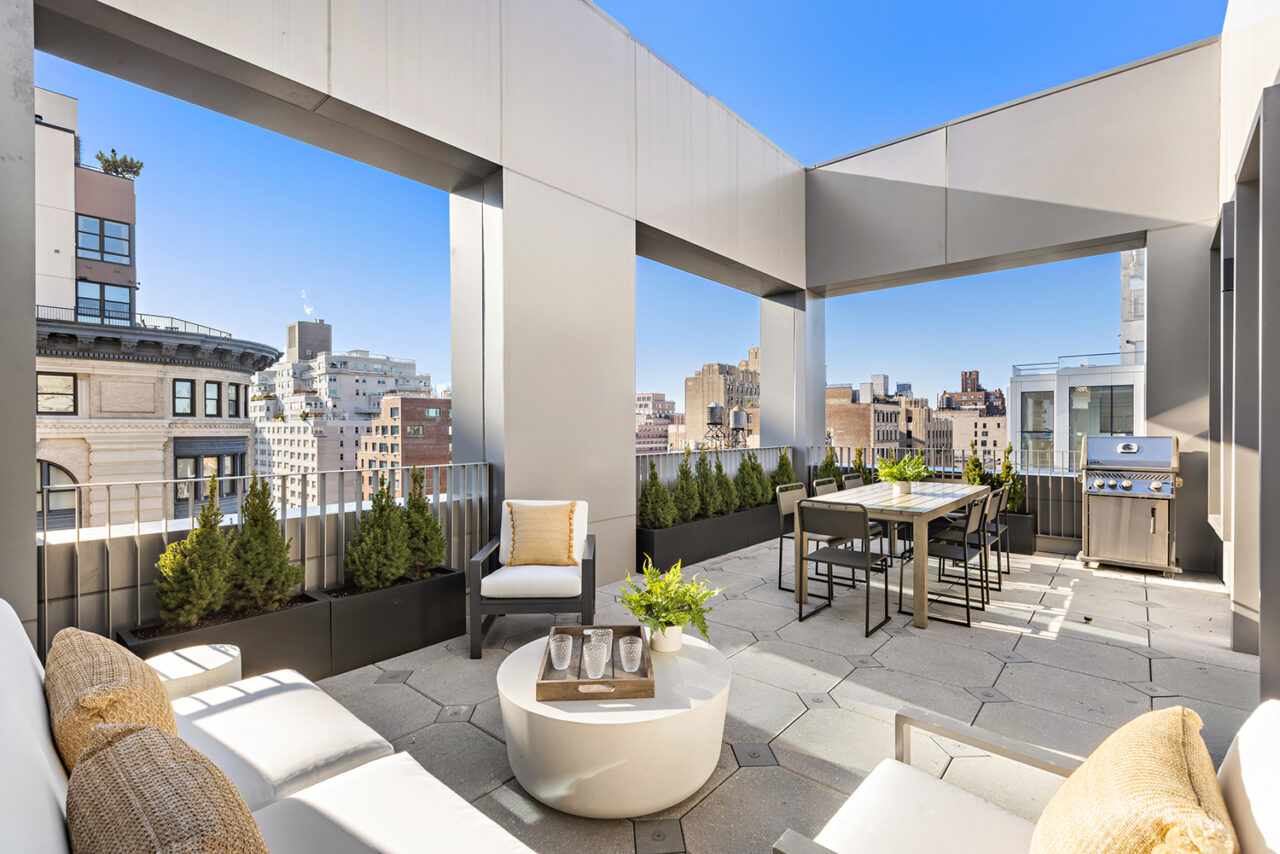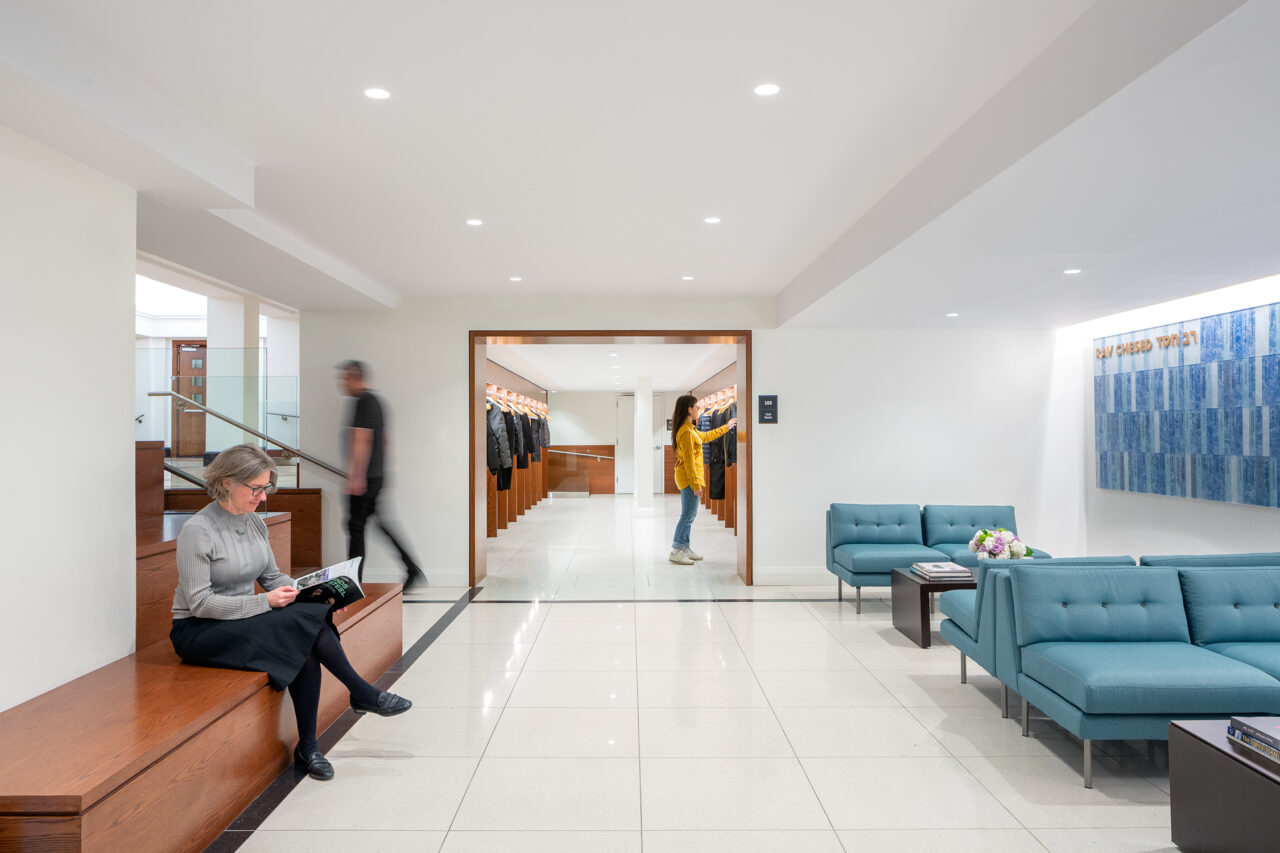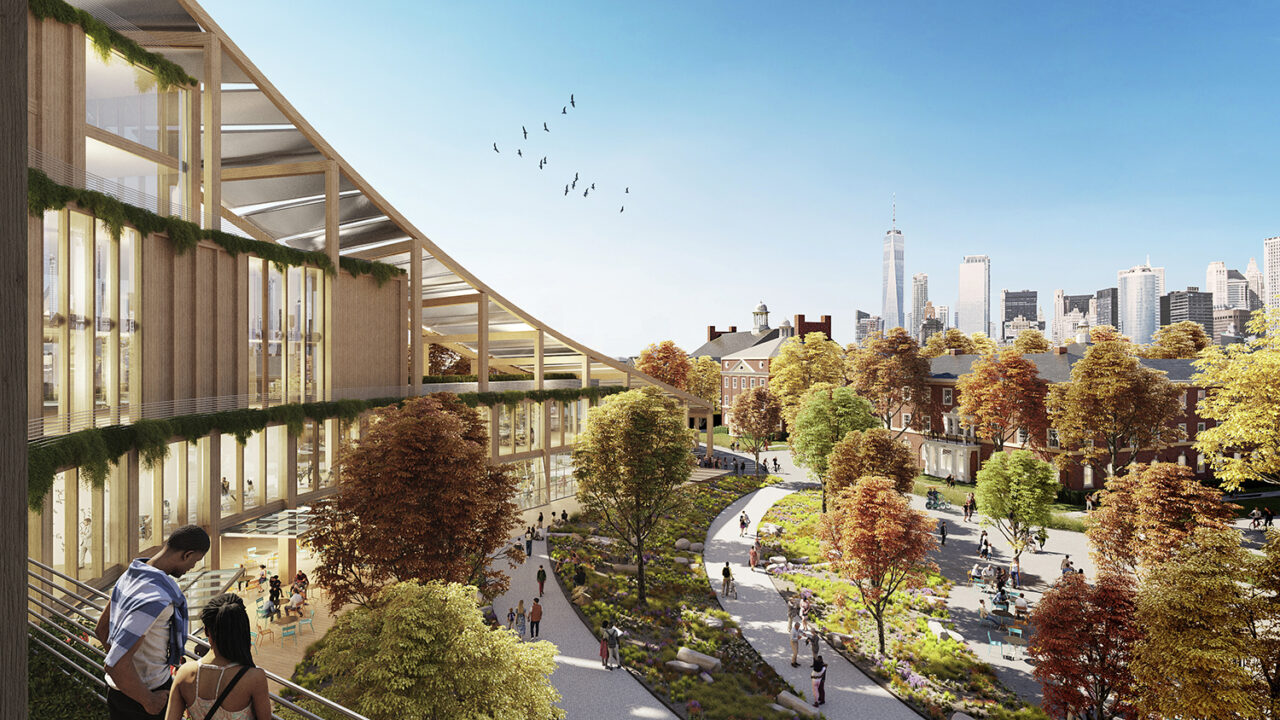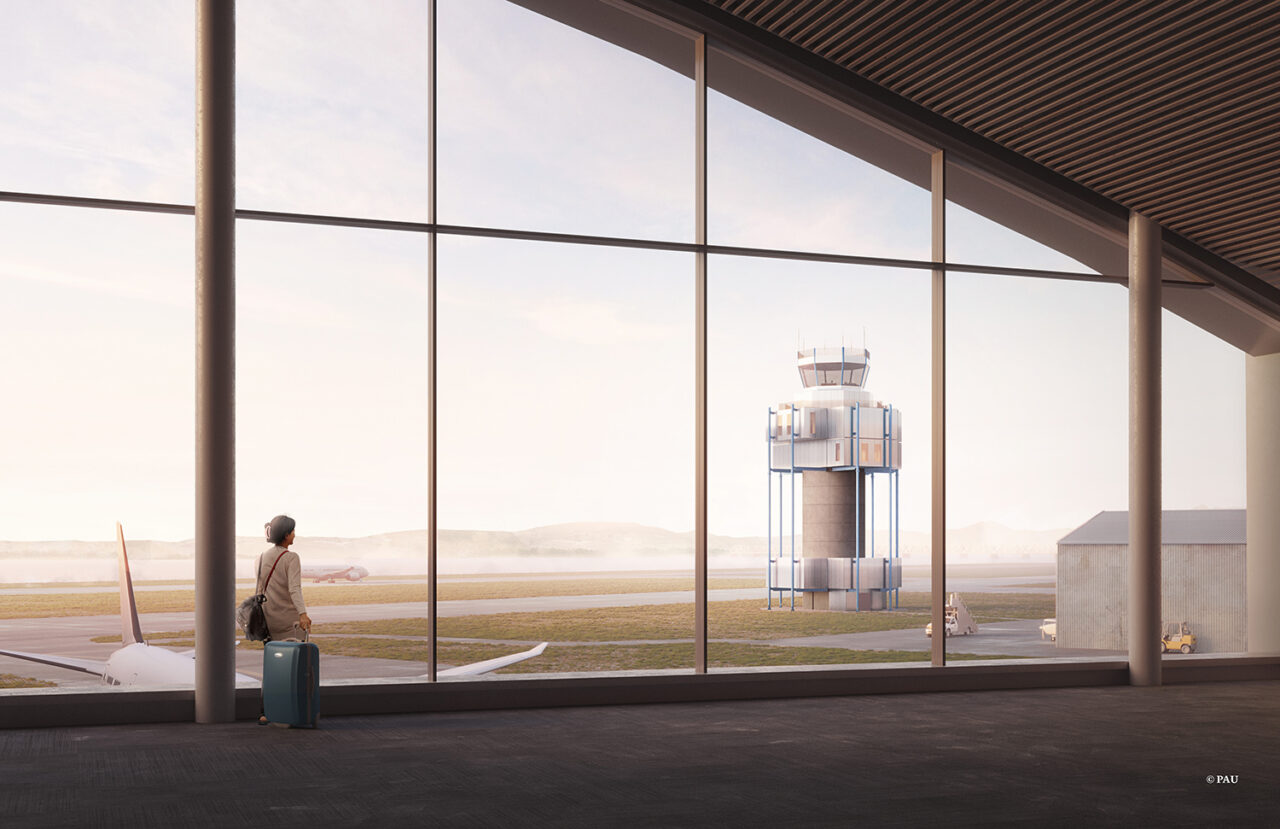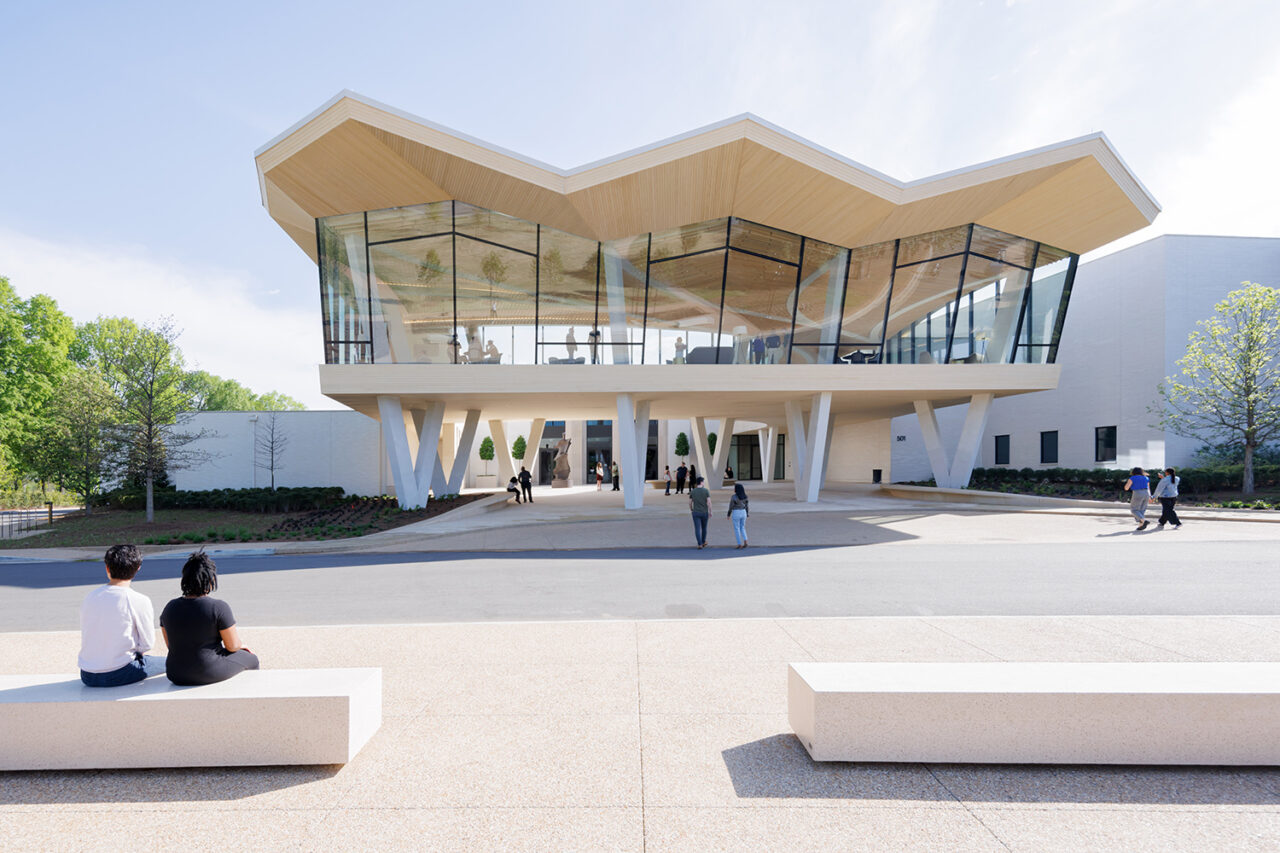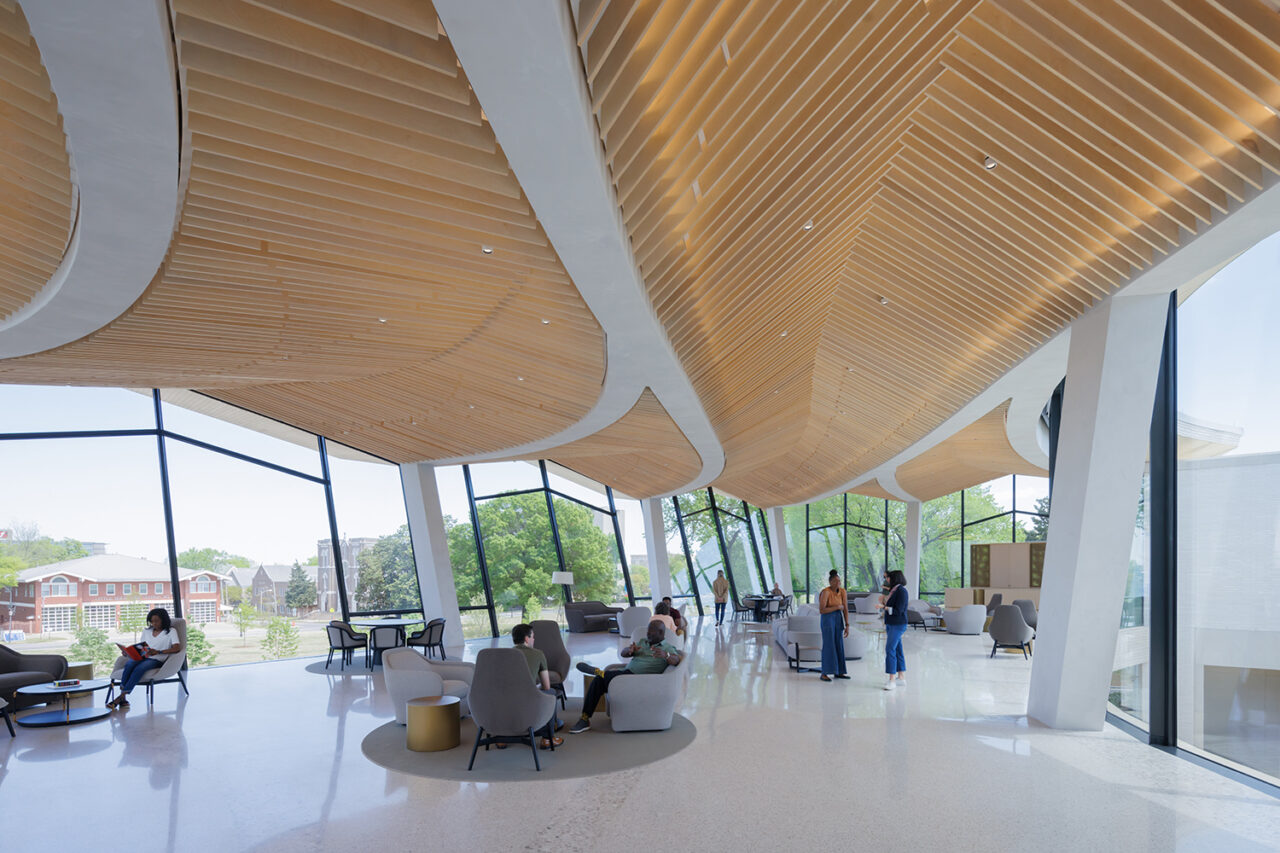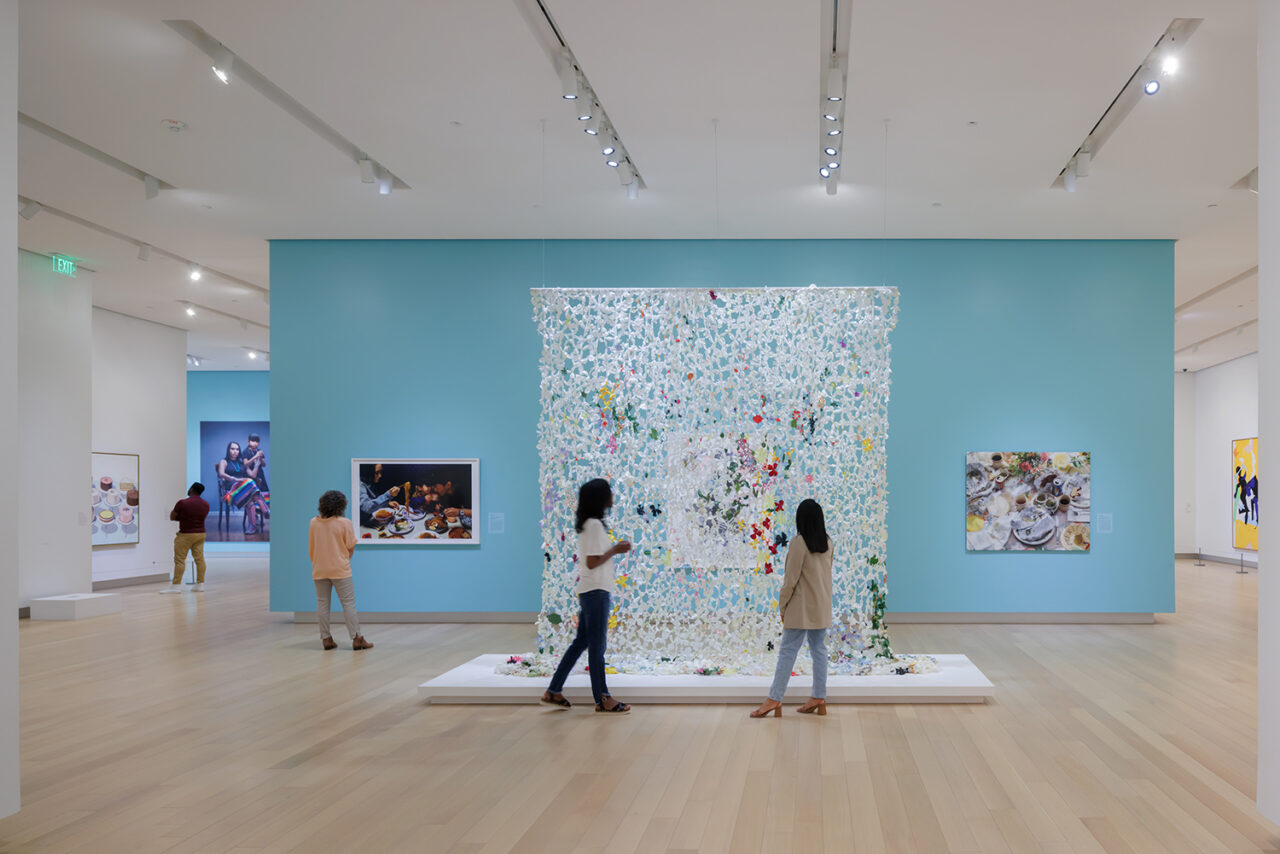by: Linda G. Miller
S9’s Market 57 Food Hall Opens in Manhattan
New York’s newest food hall, Market 57, is a James Beard Foundation-curated dining destination designed by S9 Architecture. Located at West 15th Street and the Hudson River, the food hall encompasses 16,000 square feet of the 50,000-square-foot ground level of Pier 57. The James Beard Foundation has two major programs within the space: Platform, which features a test kitchen and event space for its culinary arts programs, and Good to Go, their incubator for fast casual food concepts, which consists of standard kiosks for 15 food vendors. As the line-up of vendors will change, the food stalls are designed to be individualized with a minimal amount of tenant work. S9 also designed the two “living rooms” that are adjacent to the food hall and lead to the outdoor promenade. These comfortable yet durable spaces feature fixed and moveable seating for the public to enjoy the river and harbor views. The pier, originally designed as a shipping terminal by Emil Praeger in 1954, became a parking lot and later stood vacant for years. The design of the spaces reflects the superstructure’s concrete and steel architecture and celebrates its original use as a maritime facility. Original girders are painted charcoal grey and a reddish orange, a nod to the waterline on ocean liners. Other design elements recall the décor of the ships that once docked on Manhattan’s Westside. The firm also worked with the Hudson River Park Trust to design and program their community classroom and Discovery Tank, which are fellow neighbors on the pier, collaborating with the design studio Husband Wife on the project’s interior design. Because of its historic significance, all design interventions had to be approved by the New York State Historic Preservation Office. The pier is operated by a partnership between Jamestown and Google, and the latter has offices on the second floor of the building. As architect-of-record, Handel Architects led the renovation and restoration of the pier.
Morris Adjmi’s Förena Luxury Condo Opens in Manhattan
Located on the corner of 14th Street and Sixth Avenue—where the Village meets Chelsea—is the Förena, a new 87,000-square-foot, 50-unit luxury condo designed by Morris Adjmi Architects. The design for the interiors of the 12-story building is influenced by Scandinavian design. The building’s layered façade is composed of two “skins”: a warm brick base surface with upward cascading terraces that leads to a metal-clad crown surface. The crown volume is defined by a channeled post-and-lintel arrangement with expressed framed windows. The building features a mix of one-, two-, and three-bedroom units, several of which have private outdoor space created by the stepped edges along the upper stories. The top floor has two penthouse units with private terraces. A resident’s lounge, designed to be an extension of the private units, flows out onto the landscaped rooftop terrace. Meanwhile, a courtyard Zen garden provides a peaceful retreat.
Studio ST Renovates Ansche Chesed Synagogue
Studio ST has completed over 15,500 square feet of upgrades for Ansche Chesed Synagogue at West 100th Street and West End Avenue, designed to improve the functionality, aesthetics, and security of the building. The synagogue’s offices, previously located in the lobby, were relocated, allowing the double-height entry space to triple in size. A LULA elevator now provides easy access to the ground floor’s upper and lower lobby levels, the main sanctuary on the floor above, and the basement levels below. Biblical verses in Hebrew and English wrap around the original wall molding in the lobby. The main lobby’s original terrazzo floor was restored, and a complementary terrazzo tile was installed in the lower lobby. Wood bleacher-style seating, a large coat room/stroller parking area, and an informal coffee area provide comfortable places to socialize. The blue donor wall, designed by Chicago-based architectural, exhibition and Judaica designer Amy Reichert, symbolizes water, which is essential for creating and supporting life. The architects also redesigned the basement level, which now features a room that can accommodate large religious and communal events, along with a smaller space, used as a gym, that can easily be transformed an additional event space. A newly created multi-purpose room is sometimes used as a classroom. Repositioned on the fifth floor with views of the Hudson River, the new office suite includes a reception area, private offices, a workstation area, and a meeting room. Additional updates include replacing old plaster, adding chandeliers, improving acoustics, and modernizing the air conditioning. Built in 1927 and designed by Edward Isaac Shire, the buff-brick synagogue is a synthesis of Romanesque and Byzantine styles is a designated New York City Landmark.
J Frankl Completes 130 Hope Street in Williamsburg
J Frankl Architects has completed 130 Hope Street, a seven-story, 150,000-square-foot residential building in the Williamsburg section of Brooklyn. The building’s textural brick façade oscillates along its full-block frontage, creating a rhythm and scale resembling its traditional low-rise masonry neighbors. Cuts in the exterior break up the mass and reveal the entryway and a space leading to a private zen garden for one of the units. Residents pass through an entry bridge and arrive at a three-story glazed lobby featuring a tree that floats above a reflecting pool. An angled light well frames the sun, tracking its movement and bringing natural light into the corridors on each floor. In summer, the light reaches the area in between the entry bridge and the lobby. It also illuminates a two-line poem inlaid in a brick wall about hope, written by the architect himself and inspired by the name of the street. At one corner of the building, the exterior lifts to reveal a double-height, glass-enclosed co-working space. The gesture also creates a space for street‐side seating steps for residents and neighbors. The building contains 143 units ranging from studios to two-bedrooms, some of which will be designated as affordable. The project also features a roof deck and a semi-enclosed courtyard. Each floor near the elevator banks is outfitted with semi-enclosed nooks where kids can play and adults can relax. The project is developed by Clipper Equity.
Stony Brook to Serve as Anchor Institution for SOM-Designed New York Climate Exchange
New York City Mayor Eric Adams and the Trust for Governors Island announced that Stony Brook University will serve as the anchor institution for the development of the new climate solutions center designed by Skidmore Owings & Merrill (SOM). The New York Climate Exchange will be a first-of-its kind international center for developing and deploying solutions to our global climate crisis, while also acting as a regional hub for our rapidly evolving green economy. Complementing the natural landscape of Governors Island and the urban landscape of New York City, the design weaves new architecture into the island’s beloved park to create a living laboratory for research, education, and public enjoyment. The Exchange will showcase resiliency and sustainability, as it is set to become the first set of buildings in New York City to meet Living Building Challenge standards and be one of the first sites in the country to achieve True Zero Waste certification, meet 100 percent of its non-potable water demand with rainwater and treated wastewater, and run entirely on electricity generated on-site—even creating enough energy to serve the city’s power grid. The project features 400,000 square feet of green-designed building space, including research labs, classroom spaces, exhibitions, greenhouses, and housing facilities. As the lead architect on Stony Brook’s team, SOM, in collaboration with Mathews Nielsen Landscape Architects, Buro Happold, and Langan, has designed a model for sustainability, deploying energy-positive design strategies including mass timber construction, on-site solar power generation, and the integration of existing buildings to achieve a net zero energy campus.
FAA Selects PAU to Design Next Generation of Air Control Towers
The Federal Aviation Administration (FAA) has selected Practice for Architecture and Urbanism (PAU) to design the next generation of air control towers. The new prototype will replace aging control towers at over 100 regional and municipal airports across the United States. PAU’s design builds upon the legacy of I.M. Pei’s mid-century towers, which will be updated to address the evolution of aviation technology and safety, along with changing environmental and climate conditions. The streamlined design of the new towers, featuring a composition of geometries and exposed beams and columns, expresses its structural, mechanical, and operational building systems. They are standardized yet highly flexible, allowing for customizable colors and materials to meet the needs and reflect the local identities of their respective sites. The towers will also accommodate varied structural systems, ranging in height from 63 to 119 feet and utilizing different combinations of precast concrete and sustainable cross-laminated timber to meet requirements for a range of seismic and climate zones. The interior spaces prioritize the health and wellness of air traffic controllers, providing integrated daylighting and comfort systems and fresh air ventilation to create the most hygienic environments possible, while incorporating materials and finishes that ensure ease of maintenance over time. Designed in shippable parts, the modular prototypes also enable an efficient construction process, emphasizing shop fabrication over on-site work and decreasing each tower’s carbon footprint. Construction could begin as early as 2024 on an initial set of 30 control towers throughout the country. The new towers are a major component of the US Department of Transportation’s plan to achieve net-zero greenhouse gas emissions from the aviation sector by 2050.
Arkansas Museum of Fine Arts Opens After Studio Gang Renovation
The Arkansas Museum of Fine Arts in downtown Little Rock has opened after undergoing a major transformation of its building and grounds. Studio Gang’s design revitalizes existing structures and unites them with a central addition, a 133,000-square-foot building that establishes a new architectural identity. This new structure features a “blossoming” roof, an innovative, folded-plate structure made of cast-in-place concrete that spans the entire length of the building from north to south. Stepping down in height with the site’s topography, its clerestory windows fill the interior of the museum with natural light, while its sheltering overhangs protect users from the sun. The addition’s park-side entrance to the south complements its historic 1937 Art Deco façade on the museum’s north entrance. The addition also creates a light-filled, connective space that guides guests into galleries, the art school, the performing arts theater, The Cultural Living Room, the museum store, and a restaurant with a covered outdoor dining terrace. The museum’s permanent collection and temporary exhibitions each have dedicated galleries. Additional spaces include a new media gallery and the Art Perch, a large window in the northernmost gallery with built-in seating that gives arriving guests a “sneak peek” of featured artworks displayed inside. From inside the gallery, the window provides a view of the outdoor landscape and a comfortable place from which to view the art. The design also treats architecture and landscape as essentially linked components: SCAPE’s 11-acre landscape extends the museum experience into the park and features 2,200 linear feet of new walking paths, outdoor sculptures, and curving, sculptural benches, along with a biodiverse array of new plantings that provide shade and beauty for indoor/outdoor social spaces.
In Case You Missed It…
The first phase of structural repair work on the New York State Pavilion at Flushing Meadows Corona Park has been completed, originally designed by Philip Johnson for the 1964-65 New York World’s Fair. To mark the occasion, the NYC Department of Parks and Recreation showcased the newly added architectural lighting by L’Observatoire International. Phase II of the project, which is currently in the planning stages, would bring increased stability to the structures and allow for limited guided tours of the towers in the future. Lead design consultant Silman collaborated on the project with Jan Hird Pokorny Architects.
HOK has been selected to design the first dedicated soccer stadium for the New York City FC in the Willets Point section of Queens. The 25,000-seat facility is expected to be ready for the 2027 season.
Cooper Robertson has been selected to help reimagine Sacramento’s River District, an 800-acre stretch of downtown-adjacent industrial land in the California capital. The plan is meant to help guide the area’s transformation into a mixed-use destination with new housing, commercial spaces, and recreational opportunities. The project is led by local landscape architect ATLAS Lab and the Sacramento River District Property and Business Improvement District.
Practice for Architecture and Urbanism has joined ASTM North America and HOK as Collaborating Design Architect on the new plan to redevelop Penn Station.
Tadao Ando Architect & Associates has designed Karl Lagerfeld: A Line of Beauty for the Costume Institute at the Metropolitan Museum of Art. The exhibition serves as a physical manifestation of Karl Lagerfeld’s creativity as expressed by the architect, who had a professional relationship with the fashion designer since 1992. The exhibition will be on view May 5 through July 16, 2023.
A team composed of Dattner Architects, SCAPE, Indigo River, and Kimley-Horn has been selected to reimagine the former Union Dry Dock, the final industrial property on Hoboken’s waterfront to be converted into a public open space. The team will be conducting a public survey, followed by a series of community meetings that will inform the design.
The New York Landmarks Conservancy awarded the 2023 Lucy G. Moses Preservation Project Awards on April 19 to 1065 Clay Avenue (Mary Kay Judy Architectural & Cultural Heritage Conservation), 131 Duane Street (Jonathan Schloss / Architect, Walter B. Melvin Architects), 69th Regiment Armory (Hoffmann Architects + Engineers), Asia Art Archive in America (Baxt Ingui Architects), Castle Clinton National Monument (John G. Waite Associates Architects), Church of Saint Mary the Virgin (Jan Hird Pokorny Associates), the Church of St. Luke & St. Matthew (Li/Saltzman Architects), Lefferts Historic House (Prospect Park Alliance), New York State Pavilion (Jan Hird Pokorny Associates), Pier 57 (Handel Architects, Higgins, Quasebarth & Partners), Roosevelt Island Lighthouse (Thomas A. Fenniman Architect), and St. Luke’s Historic Pavilions (CetraRuddy, Thornton Tomasetti).








